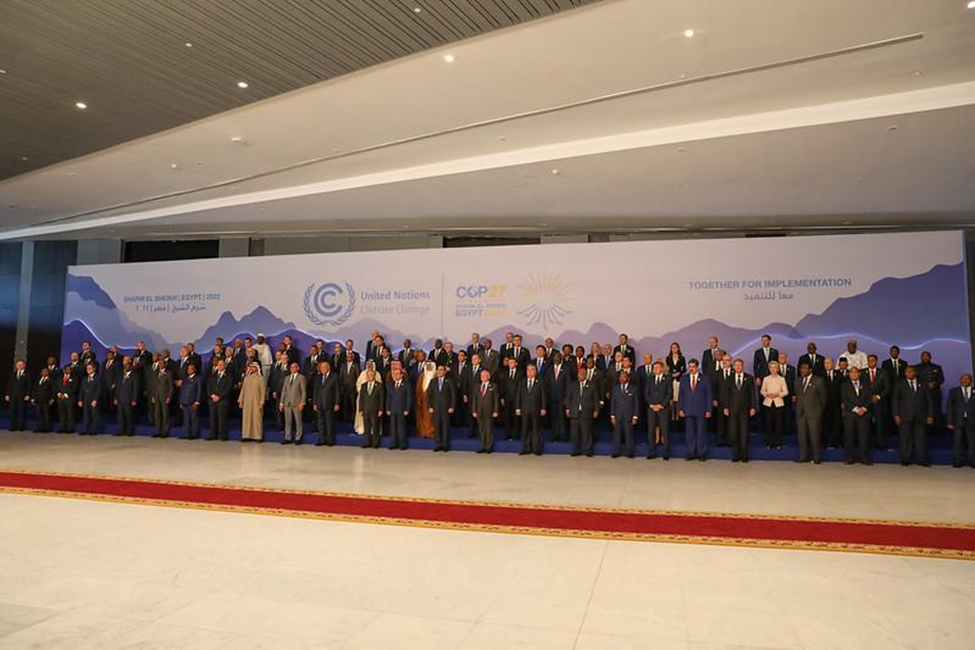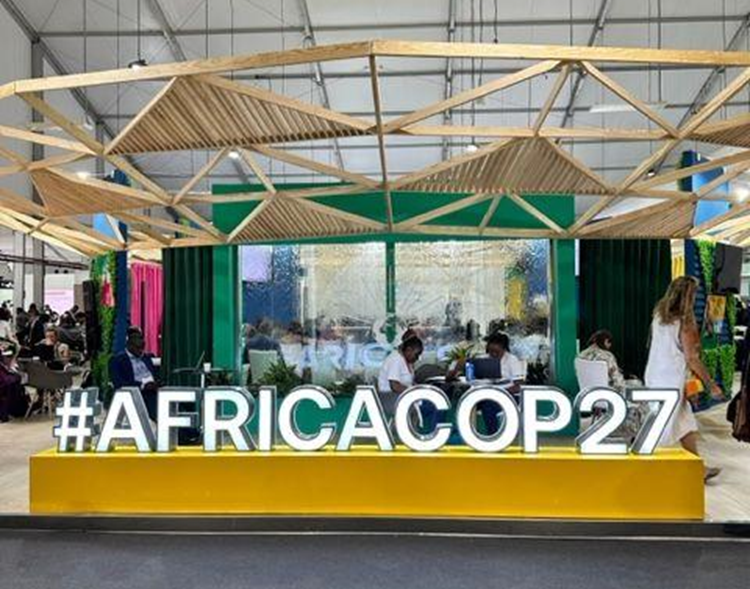COP27: balancing historic decisions and alarming shortcomings


· 5 min read
As the sun rose on Sunday in the resort town of Sharm El Sheikh, the first draft of COP27 was finalized. The document includes both historic breakthroughs and a concerning lack of strengthened commitments. While women, youth, and Indigenous leaders were once again notably underrepresented in negotiations, as you can see in the “family photo” below, their voices and knowledge were heard throughout the pavilions.

As the second most attended COP to date, over 30,000 attendees and delegations from almost 200 countries were in attendance to discuss mitigation, adaptation, loss and damage, climate finance, and collective action to try to keep the goal of limiting warming to 1.5 degrees alive. Every fraction of a degree matters – especially for those most impacted by climate change and who have contributed the least to the problem.
The biggest news to come out of COP27: after thirty years of persistent advocacy from activists on the frontlines of climate change, a first small, yet symbolic, step was taken to address climate injustice.
Countries agreed to create a fund for addressing loss and damage (both economic and non-economic losses) for those most impacted by climate change. While this news was celebrated, the details are yet to be formulated. The hope is that this new mechanism will be rightfully and fully funded by those who have emitted the most greenhouse gases and who have caused the most harm — unlike unfulfilled promises of the $100B annual pledge to provide climate finance for low- and middle-income countries or the fact that only 7% of the funding from the $1.7B pledge to support Indigenous and community forest tenure has actually gone to Indigenous or local organizations.
In other positive news, 50 more countries signed on to the Global Methane Pledge since last year’s COP in Glasgow. This means nearly 150 countries worldwide have a shared goal to cut methane emissions by at least 30 percent by 2030 from 2020 levels. Tackling methane is crucial to reducing shorter term, super-potent emissions and keeping global climate goals within reach.

Local knowledge and action were also emphasized throughout negotiations and at various pavilions.
African-led initiatives like the Alliance for Green Infrastructure in Africa (AGIA) – launched at COP27 – or the African Multi-Hazard Early Warning and Action System (AMHEWAS) show how locally-led programs can better support people through disaster risk reduction, strengthen resilience, and accelerate finance for green infrastructure.
The Executive Action Plan for the Early Warnings for All initiative also aspires to assist with preparedness and responses to extreme and dangerous weather with more funding. As the human and economic impacts of recent flooding in Pakistan and Nigeria due to inadequate warning systems shows, this initiative will be crucial to protect human lives — especially for communities on the frontlines of the climate crisis. As António Guterres, United Nations Secretary General stated, "Three times more people are displaced by climate disasters than war. Half of humanity is already in the danger zone”.
In other news, the First Movers Coalition – launched by President Biden in 2021 as a public-private initiative to accelerate innovation in hard-to-abate sectors including industry and transportation – has more than doubled its membership, announced a new cement and concrete initiative, and pledged to purchase at least 10% near-zero carbon cement and concrete by 2030.
Delegations also responded positively to a set of initiatives proposed by Mia Mottley, the prime minister of Barbados, that focuses on transforming global financial institutions — primarily the IMF, World Bank, and other development banks — to take greater financial risks and lend money to developing countries at much lower rates. Such an approach could unlock up to $1 trillion in capital; which is needed to fund low-carbon development and build climate resilience in emerging economies.
Although parties involved in high-level negotiations reaffirmed the goal of keeping global temperatures to less than 1.5°C above pre-industrial levels, the conference fell short on renewed commitments to reduce emissions dramatically. Current commitments still won’t limit global temperature rise to well below 2°C as stated in the Paris Agreement. Only 24/193 countries had updated their nationally-determined contributions prior to COP27.
During the final remarks at COP27, Alok Sharma, former UK cabinet minister and COP26 president, emphasized the concern for the absence of language around emissions peaking before 2025 and a clear commitment to phase out all fossil fuels. The COP27 text reflects the urgent need for a just energy transition through enhanced partnership from multiple stakeholders, but also expresses concern for a lack of enhanced commitments and action on countries’ nationally determined contributions and gap between levels of adaptation and levels needed to respond to the adverse effects of climate change. Although there were $230 million in enhanced pledges for the Adaptation Fund, the amount available is miniscule compared to the scale of what is necessary to advance locally-led adaptation.
Overall, while COPs are an important part of collective action to reach our global climate goals, all stakeholders — policymakers, leaders, local communities, businesses, and funders — must move beyond words to action. As Mia Mottley directly stated, “This world looks still—too much like it did when it was a part of an imperialistic empire.”
Now that COP27 is over, the hard work toward implementation, stronger commitments, and action continues. Specifically, high-emitting countries must dramatically reduce emissions and transition to clean energy, and leaders, organizations, and community members must engage in authentic and intentional collaboration to advance partnerships and fulfill their commitments to protect the most climate vulnerable communities. We must work together because, as Mottley has said, “We have the collective capacity to transform.”
Illuminem Voices is a democratic space presenting the thoughts and opinions of leading Sustainability & Energy writers, their opinions do not necessarily represent those of illuminem.
illuminem briefings

Biodiversity · Nature
John Leo Algo

Ethical Governance · Environmental Sustainability
Steven W. Pearce

Adaptation · Mitigation
The Washington Post

Biodiversity · Nature
Yale Climate Connections

Effects · Climate Change
Euractiv

Carbon Market · Public Governance